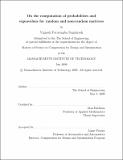| dc.contributor.advisor | Alan Edelman. | en_US |
| dc.contributor.author | Peruvamba Sundaresh, Vignesh | en_US |
| dc.contributor.other | Massachusetts Institute of Technology. Computation for Design and Optimization Program. | en_US |
| dc.date.accessioned | 2010-05-25T19:19:30Z | |
| dc.date.available | 2010-05-25T19:19:30Z | |
| dc.date.copyright | 2009 | en_US |
| dc.date.issued | 2009 | en_US |
| dc.identifier.uri | http://hdl.handle.net/1721.1/54840 | |
| dc.description | Thesis (S.M.)--Massachusetts Institute of Technology, Computation for Design and Optimization Program, 2009. | en_US |
| dc.description | This electronic version was submitted by the student author. The certified thesis is available in the Institute Archives and Special Collections. | en_US |
| dc.description | Cataloged from PDF version of thesis. | en_US |
| dc.description | Includes bibliographical references (p. 43-44). | en_US |
| dc.description.abstract | Can you imagine doing hundreds of millions of operations on non-integers and not obtaining a single round-off error? For n < 12, the algorithm used in this thesis does exactly that. We took advantage of a floating point property that we have not seen used before. If only we had quad precision we could have gone even further and extended the algorithm without round-off error for higher values of 'n'. The problem in question concerns whether the eigenvalues are real or complex. The eigenvalues of an n-by-n real random matrix whose elements are independent random variables with standard normal are examined. An exact expression to determine the probability Pn,k that exactly k eigenvalues are real are derived in [1]. This expression was used to compute the probabilities Pn,k, but the computation was achieved only up to n = 9. For higher values of n, the symbolic expressions generated during the course of an algorithm to compute an exact probability as expressed in Mathematica code requires large amounts of memory. In this thesis, we target development of a more efficient algorithm. The symbolic algorithm implemented in Mathematica is converted into an equivalent numerical version and is implemented using MATLAB. After implementing the serial code in MATLAB, the code is parallelized using a client-server parallel computing platform named Star-p. This modified code implementation along with superior hardware in terms of better processor speeds and larger memory, has enabled the probability evaluation for all values of k up to n= 11, and for certain k values for n = 12 and 13. | en_US |
| dc.description.abstract | (cont.) An expression for the expected number of real eigenvalues En=o kpn,k is obtained in paper [2]. Results relating the rational and irrational parts of the summations n =o kpn,ki, En k=0 (Pk n,k and En= - n,k 0 k)Pn,k are conjectured. Three eigenvalue algorithms, the block Davidson, the block KrylovSchur and the Locally optimal Block Pre-conditioned Conjugate Gradient Method (LOBPCG) are analyzed and their performance on different types of matrices are studied. The performance of the algorithms as a function of the parameters , block size, number of blocks and the type of preconditioner is also examined in this thesis. The block Krylov Schur Algorithm for the matrices which are used for the experiments have proved to much superior to the others in terms of computation time. Also its been more efficient in finding eigenvalues for matrices representing grids with Neumann boundary conditions which have at least one zero eigenvalue. There exists one optimal combination of block size and number of blocks at which the time for eigenvalue computation is minimum. These parameters have different effects for different cases. The block Davidson algorithm has also been incorporated with the locking mechanism and this implementation is found to be much superior to its counterpart without the locking mechanism for matrices which have at least one zero eigenvalue. | en_US |
| dc.description.statementofresponsibility | by Vignesh Peruvamba Sundaresh. | en_US |
| dc.format.extent | 6, 65 p. | en_US |
| dc.language.iso | eng | en_US |
| dc.publisher | Massachusetts Institute of Technology | en_US |
| dc.rights | M.I.T. theses are protected by
copyright. They may be viewed from this source for any purpose, but
reproduction or distribution in any format is prohibited without written
permission. See provided URL for inquiries about permission. | en_US |
| dc.rights.uri | http://dspace.mit.edu/handle/1721.1/7582 | en_US |
| dc.subject | Computation for Design and Optimization Program. | en_US |
| dc.title | On the computation of probabilities and eigenvalues for random and non-random matrices | en_US |
| dc.type | Thesis | en_US |
| dc.description.degree | S.M. | en_US |
| dc.contributor.department | Massachusetts Institute of Technology. Computation for Design and Optimization Program | |
| dc.identifier.oclc | 587445752 | en_US |

